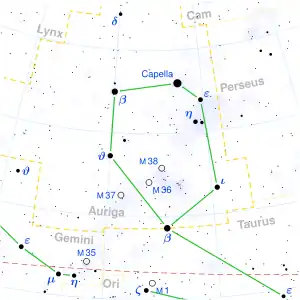NO Aurigae
NO Aurigae is a pulsating variable star in the constellation Auriga.
 | |
| Observation data Epoch J2000 Equinox J2000 | |
|---|---|
| Constellation | Auriga |
| Right ascension | 05h 40m 42.05023s[1] |
| Declination | +31° 55′ 14.1920″[1] |
| Apparent magnitude (V) | 6.21[2] (6.06 - 6.44[3]) |
| Characteristics | |
| Evolutionary stage | Asymptotic Giant Branch[4] |
| Spectral type | M2S Iab[3] |
| U−B color index | +2.22[5] |
| B−V color index | +2.09[5] |
| R−I color index | +1.41[5] |
| Variable type | LC[3] |
| Astrometry | |
| Radial velocity (Rv) | 7.21±0.45[6] km/s |
| Proper motion (μ) | RA: 0.13±0.47[1] mas/yr Dec.: −3.65±0.26[1] mas/yr |
| Parallax (π) | 0.4541 ± 0.1601[7] mas |
| Distance | 600[8] pc |
| Absolute magnitude (MV) | –5.88[2] |
| Details | |
| Mass | 4.93[9] M☉ |
| Radius | 630[2] R☉ |
| Luminosity | 67,000[10] - 73,000[2] L☉ |
| Surface gravity (log g) | 0.1[2] cgs |
| Temperature | 3,700[2] K |
| Other designations | |
| Database references | |
| SIMBAD | data |
| Data sources: | |
| Hipparcos Catalogue, CCDM (2002), Bright Star Catalogue (5th rev. ed.) | |
Variability
NO Aurigae is listed in the General Catalogue of Variable Stars as a slow irregular variable, indicating that no regularity could be found in the brightness variations. Other studies have suggested possible periods of 102.1, 173, and 226 days, and would classify it as a semiregular variable star.[11] The maximum visual magnitude range is 6.05–6.50.[11]
Properties
Most studies of NO Aurigae treat it as a supergiant member of the Auriga OB1 stellar association at about 1.4 kpc.[10][12] On this basis it has a luminosity around 70,000 L☉ and a radius around 630 R☉.[2][10]
NO Aurigae is an MS star, intermediate between spectral type M and S. These are typically Asymptotic Giant Branch stars which can appear with supergiant spectra due to their large size and low mass.[4] Possible detection of Technetium in the spectrum is a symptom of the third dredge-up which occurs only in late AGB stars.[12] The revised Hipparcos parallax places it at 595 pc, around the third of the distance of Aur OB1, suggesting about a tenth of the derived luminosity for NO Aur. Calculations using this distance give luminosities of 15,600 L☉, 7,938 L☉,[13] or 6,968 L☉.[9]
References
- Van Leeuwen, F. (2007). "Validation of the new Hipparcos reduction". Astronomy and Astrophysics. 474 (2): 653–664. arXiv:0708.1752. Bibcode:2007A&A...474..653V. doi:10.1051/0004-6361:20078357. S2CID 18759600.
- Levesque, Emily M.; Massey, Philip; Olsen, K. A. G.; Plez, Bertrand; Josselin, Eric; Maeder, Andre; Meynet, Georges (2005). "The Effective Temperature Scale of Galactic Red Supergiants: Cool, but Not As Cool As We Thought". The Astrophysical Journal. 628 (2): 973–985. arXiv:astro-ph/0504337. Bibcode:2005ApJ...628..973L. doi:10.1086/430901. S2CID 15109583.
- Samus, N. N.; Durlevich, O. V.; et al. (2009). "VizieR Online Data Catalog: General Catalogue of Variable Stars (Samus+ 2007-2013)". VizieR On-line Data Catalog: B/GCVS. Originally Published in: 2009yCat....102025S. 1. Bibcode:2009yCat....102025S.
- Guandalini, R.; Busso, M. (2008). "Infrared photometry and evolution of mass-losing AGB stars. II. Luminosity and colors of MS and S stars". Astronomy and Astrophysics. 488 (2): 675–684. arXiv:0806.4591. Bibcode:2008A&A...488..675G. doi:10.1051/0004-6361:200809932. S2CID 14294870.
- Ducati, J. R. (2002). "VizieR Online Data Catalog: Catalogue of Stellar Photometry in Johnson's 11-color system". CDS/ADC Collection of Electronic Catalogues. 2237. Bibcode:2002yCat.2237....0D.
- Famaey, B.; Jorissen, A.; Luri, X.; Mayor, M.; Udry, S.; Dejonghe, H.; Turon, C. (2005). "Local kinematics of K and M giants from CORAVEL/Hipparcos/Tycho-2 data. Revisiting the concept of superclusters". Astronomy and Astrophysics. 430: 165. arXiv:astro-ph/0409579. Bibcode:2005A&A...430..165F. doi:10.1051/0004-6361:20041272. S2CID 17804304.
- Brown, A. G. A.; et al. (Gaia collaboration) (August 2018). "Gaia Data Release 2: Summary of the contents and survey properties". Astronomy & Astrophysics. 616. A1. arXiv:1804.09365. Bibcode:2018A&A...616A...1G. doi:10.1051/0004-6361/201833051. Gaia DR2 record for this source at VizieR.
- Reiter, Megan; Marengo, Massimo; Hora, Joseph L.; Fazio, Giovanni G. (2015). "A Spitzer/IRAC characterization of Galactic AGB and RSG stars". Monthly Notices of the Royal Astronomical Society. 447 (4): 3909. arXiv:1501.02749. Bibcode:2015MNRAS.447.3909R. doi:10.1093/mnras/stu2725. S2CID 118515353.
- Hohle, M. M.; Neuhäuser, R.; Schutz, B. F. (April 2010), "Masses and luminosities of O- and B-type stars and red supergiants", Astronomische Nachrichten, 331 (4): 349, arXiv:1003.2335, Bibcode:2010AN....331..349H, doi:10.1002/asna.200911355, S2CID 111387483
- Mauron, N.; Josselin, E. (2011). "The mass-loss rates of red supergiants and the de Jager prescription". Astronomy and Astrophysics. 526: A156. arXiv:1010.5369. Bibcode:2011A&A...526A.156M. doi:10.1051/0004-6361/201013993. S2CID 119276502.
- Watson, C. L. (2006). "The International Variable Star Index (VSX)". The Society for Astronomical Sciences 25th Annual Symposium on Telescope Science. Held May 23–25. 25: 47. Bibcode:2006SASS...25...47W.
- Josselin, E.; Plez, B. (2007). "Atmospheric dynamics and the mass loss process in red supergiant stars". Astronomy and Astrophysics. 469 (2): 671. arXiv:0705.0266. Bibcode:2007A&A...469..671J. doi:10.1051/0004-6361:20066353. S2CID 17789027.
- McDonald, I.; Zijlstra, A. A.; Boyer, M. L. (2012). "Fundamental Parameters and Infrared Excesses of Hipparcos Stars". Monthly Notices of the Royal Astronomical Society. 427 (1): 343–57. arXiv:1208.2037. Bibcode:2012MNRAS.427..343M. doi:10.1111/j.1365-2966.2012.21873.x. S2CID 118665352.